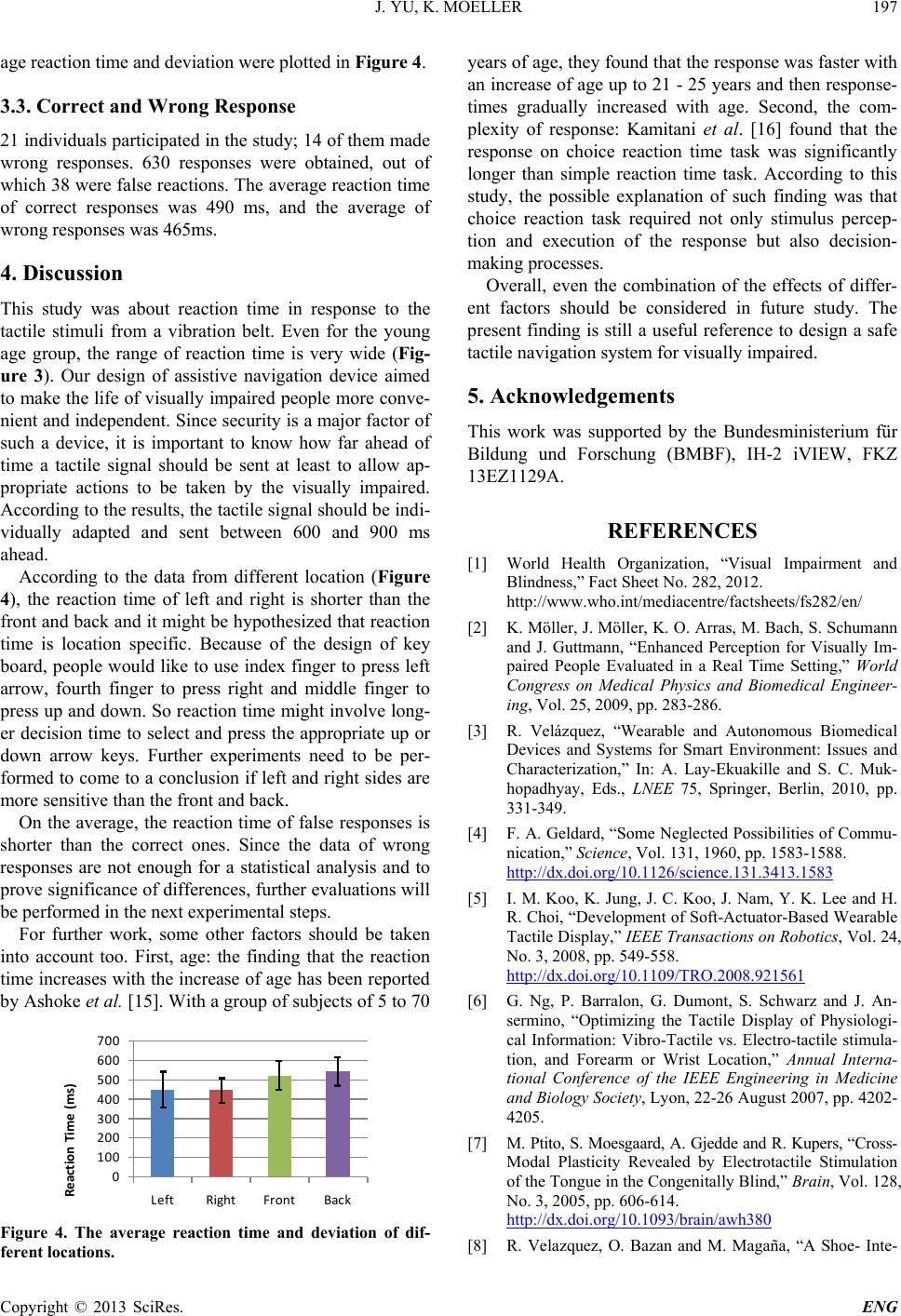
J. YU, K. MOELLER
Copyright © 2013 SciRes. ENG
age reaction time and deviation were plotted in Figure 4.
3.3. Correct and Wrong Response
21 individuals participated in the study; 14 of them made
wrong responses. 630 responses were obtained, out of
which 38 were false reactions. The average reaction time
of correct responses was 490 ms, and the average of
wrong responses was 465ms.
4. Discussion
This study was about reaction time in response to the
tactile stimuli from a vibration belt. Even for the young
age group, the range of reaction time is very wide (Fig-
ure 3). Our design of assistive navigation device aimed
to make the life of visually impaired people more conve-
nient and independent. Since security is a major factor of
such a device, it is important to know how far ahead of
time a tactile signal should be sent at least to allow ap-
propriate actions to be taken by the visually impaired.
According to the results, the tactile sign al should be indi-
vidually adapted and sent between 600 and 900 ms
ahead.
According to the data from different location (Figure
4), the reaction time of left and right is shorter than the
front and back and it might be hypothesized that reaction
time is location specific. Because of the design of key
board, people would like to use index finger to press left
arrow, fourth finger to press right and middle finger to
press up and down. So reaction time might involve long-
er decision time to select and press the appropriate up or
down arrow keys. Further experiments need to be per-
formed to come to a conclusion if left and right sides are
more sensitive than the front and back.
On the average, the reaction time of false responses is
shorter than the correct ones. Since the data of wrong
responses are not enough for a statistical analysis and to
prove significance of differences, further evaluation s will
be performed in the next experimental steps.
For further work, some other factors should be taken
into account too. First, age: the finding that the reaction
time increases with the increase of age has been reported
by Ashoke et al. [15]. With a group of subjects of 5 to 70
Figure 4. The average reaction time and deviation of dif-
ferent locations.
years of age, they found that the response was faster with
an increase of age up to 21 - 25 years and then r esponse-
times gradually increased with age. Second, the com-
plexity of response: Kamitani et al. [16] found that the
response on choice reaction time task was significantly
longer than simple reaction time task. According to this
study, the possible explanation of such finding was that
choice reaction task required not only stimulus percep-
tion and execution of the response but also decision-
making processes.
Overall, even the combination of the effects of differ-
ent factors should be considered in future study. The
present finding is still a useful reference to design a safe
tactile navigation system for visua lly impaired.
5. Acknowledgements
This work was supported by the Bundesministerium für
Bildung und Forschung (BMBF), IH-2 iVIEW, FKZ
13EZ1129A.
REFERENCES
[1] World Health Organization, “Visual Impairment and
Blindness,” Fact Sheet No. 282, 2012.
http://www.who.int/mediacentre/factsheets/fs282/en/
[2] K. Möller, J. Mölle r, K. O. Arras, M. Bach, S. Schumann
and J. Guttmann, “Enhanced Perception for Visually Im-
paired People Evaluated in a Real Time Setting,” World
Congress on Medical Physics and Biomedical Engineer-
ing, Vol. 25, 2009, pp. 283-286.
[3] R. Velázquez, “Wearable and Autonomous Biomedical
Devices and Systems for Smart Environment: Issues and
Characterization,” In: A. Lay-Ekuakille and S. C. Muk-
hopadhyay, Eds., LNEE 75, Springer, Berlin, 2010, pp.
331-349.
[4] F. A. Geldard, “Some Neglected Possibilities of Commu-
nication,” Science, Vol. 131, 1960, pp. 1583-1588.
http://dx.doi.org/10.1126/science.131.3413.1583
[5] I. M. Koo, K. Jung, J. C. Koo, J. Na m, Y. K. Lee and H.
R. Choi, “Development of Soft-Actuator-Based Wearable
Tactile Display,” IEEE Transactions on Robotics, Vol. 24 ,
No. 3, 2008, pp. 549-558.
http://dx.doi.org/10.1109/TRO.2008.921561
[6] G. Ng, P. Barralon, G. Dumont, S. Schwarz and J. An-
sermino, “Optimizing the Tactile Display of Physiologi-
cal Information: Vibro-Tactile vs. Electro-tactile stimula-
tion, and Forearm or Wrist Location,” Annual Interna-
tional Conference of the IEEE Engineering in Medicine
and Biology Society, Lyon, 22-26 August 2007, pp. 4202-
4205.
[7] M. Ptito, S. Moesgaard, A. Gjedde and R. Kuper s, “Cross-
Modal Plasticity Revealed by Electrotactile Stimulation
of the Tongue in the Congenitally Blind,” Brain, Vol. 128,
No. 3, 2005, pp. 606-614.
http://dx.doi.org/10.1093/brain/awh380
[8] R. Velazquez, O. Bazan and M. Magaña, “A Shoe- Inte-